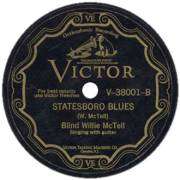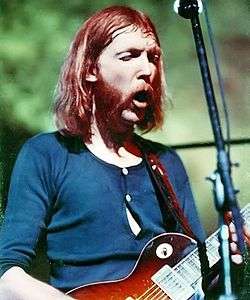Statesboro Blues
| "Statesboro Blues" | ||||
|---|---|---|---|---|
 | ||||
| Single by Blind Willie McTell | ||||
| A-side | "Three Women Blues" | |||
| Released | 1928 | |||
| Format | 10-inch 78-rpm record | |||
| Recorded | Atlanta, Georgia, October 17, 1928 | |||
| Genre | Piedmont blues | |||
| Length | 2:30 | |||
| Label | Victor V-38001 | |||
| Writer(s) | Blind Willie McTell | |||
| Blind Willie McTell singles chronology | ||||
| ||||
"Statesboro Blues" is a Piedmont blues song written by Blind Willie McTell, who recorded it in 1928. The title refers to the town of Statesboro, Georgia. Taj Mahal recorded a popular blues-rock adaptation of the song in 1968. His version inspired a recording by the Allman Brothers Band, which is ranked number nine on Rolling Stone magazine's list of the "100 Greatest Guitar Songs of All Time".[1] In 2005, the Atlanta Journal-Constitution ranked "Statesboro Blues" number 57 on its list of "100 Songs of the South".[2]
Original song
Although McTell was born in Thomson, Georgia, in an interview he called Statesboro "my real home." He made the first recording of the song for Victor,[3] on October 17, 1928 (Victor #38001).[4] The eight sides he recorded for Victor, including "Statesboro Blues", have been described as "superb examples of storytelling in music, coupled with dazzling guitar work."[5]
Lyrics
The lyrics, a first-person narrative, appear to relate the story of a man pleading with a woman to let him in her house; the speaker calls himself "Papa McTell" in the first stanza ("Have you got the nerve to drive Papa McTell from your door?"). Throughout the song, the woman, addressed as "mama," is alternately pleaded with (to go with the speaker "up the country") and threatened ("When I leave this time, pretty mama, I'm going away to stay"). Throughout the non-linear narrative, the "Statesboro blues" are invoked—an unexplained condition from which the speaker and his entire family seem to be suffering ("I woke up this morning / Had them Statesboro blues / I looked over in the corner: grandma and grandpa had 'em too").[6] Later versions, such as the one by the Allman Brothers Band, have shorter, simplified lyrics.
As with many blues lyrics, it can be difficult to establish rules for the narrative order of the stanzas. In the case of "Statesboro Blues," Richard Blaustein attempted a structural analysis of McTell's song in an approach influenced by Claude Lévi-Strauss;[7] it is unclear whether his results are applicable to other blues songs.[8]
In 2016, the song was selected for preservation in the National Recording Registry due to its "cultural, historic, or artistic significance".[9] It is included on several compilations of McTell's recordings.
Taj Mahal adaptation
Taj Mahal recorded a "wonderful modernized version"[4] on his eponymous 1968 debut album. The song reached a wide audience by being included on the best-selling Columbia/CBS sampler album The Rock Machine Turns You On.[10] His arrangement is credited with inspiring the Allman Brothers Band.[11] Mahal had recorded "Stateboro Blues" prior to the aforementioned rendition, in 1965 or 1966, as a member of the group Rising Sons; this recording was not released until 1992.[12]
The Allman Brothers Band version

The Allman Brothers Band recorded the song at the Fillmore East in March 1971, which was first released on the 1971 album At Fillmore East.[10] Duane Allman contributes the slide guitar, which Rolling Stone later described as featuring "the moaning and squealing opening licks [that] have given fans chills at live shows."[13]
Allman's slide riffs on "Statesboro Blues" have been analyzed and transcribed in guitar magazines[14][15][16][17] and the tones of Allman's and Dickey Betts's guitars on the song were described by Guitar Player as among the "50 Greatest Tones of All Time."[18] Allman's version comes from when his brother Gregg gave him a record by Taj Mahal (containing his version of "Statesboro Blues") and a bottle of Coricidin pills, both for his birthday and as Duane had a cold that day; a short while later, Duane, who had never played slide guitar before, washed the label from the Coricidin bottle after emptying out the pills and learned how to play the song, even exhibiting it to Gregg. After Allman's death in a motorcycle crash later that year, the performance was included on the 1972 album An Anthology. In 2008, Rolling Stone magazine ranked the Allman Brothers Band's version of "Statesboro Blues" number 9 in its list of the "100 Greatest Guitar Songs of All Time".[13]
The song is still a staple of the Allman Brothers Band's live shows, with either Derek Trucks or Warren Haynes playing slide guitar. Dickey Betts also continues to play the song live.[19] It can also be found on the compilation album The Road Goes On Forever.
Other recordings include those by John Mayall, the Youngbloods, Dave Van Ronk, Chris Smither, David Bromberg, Brooks Williams, Alice Stuart, Deep Purple, Pat Travers, Tom Rush, Roy Book Binder and The Devil Makes Three.
References
- ↑ Brandon. "Rolling Stone's 100 Greatest Guitar Songs Of All Time". Stereogum. Retrieved 8 April 2015.
- ↑ Perry, Bryan (producer); Harrison, Shane; Murray, Sonia; Marino, Nick; and Ellison, Soyia. 100 Songs of the South. Retrieved 2009-10-11.
- ↑ Bastin, Bruce (1995). Red River Blues: The Blues Tradition in the Southeast. University of Illinois Press. p. 129. ISBN 978-0-252-06521-7.
- 1 2 Herzhaft, Gerard (1992). "Statesboro Blues". Encyclopedia of the Blues. University of Arkansas Press. p. 472. ISBN 1-55728-252-8.
- ↑ Eder, Bruce (1996). Erlewine, Michael, ed. Blind Willie McTell. All Music Guide to the Blues. Miller Freeman Books. p. 189. ISBN 0-87930-424-3.
- ↑ Sackheim, Eric; Shahn, Jonathan (2003). The Blues Line: Blues Lyrics from Leadbelly to Muddy Waters. Thunder's Mouth. p. 333. ISBN 978-1-56025-567-3.
- ↑ Richard, Blaustein (November 14, 1971). "The Curative Function of the Blues: A Structural Analysis". Annual Meeting of the Society for Ethnomusicology. Chapel Hill, North Carolina.
- ↑ Taft, Michael (2006). The Blues Lyric Formula. CRC. p. 106. ISBN 978-0-415-97499-8.
- ↑ "Complete National Recording Registry Listing". National Recording Preservation Board. U.S. Library of Congress. Retrieved June 3, 2016.
- 1 2 Bogdanov, Vladimir; Woodstra, Chris; Erlewine, Stephen Thomas (2003). All Music Guide to the Blues. Hal Leonard. p. 369. ISBN 978-0-87930-736-3.
- ↑ "Night Beat". Atlanta Journal-Constitution. June 5, 1992. p. E.4.
- ↑ Unterberger, Richie. "Rising Sons Featuring Taj Mahal & Ry Cooder: Review". AllMusic. Retrieved June 3, 2016.
- 1 2 Serpick, Evan. "9: "Statesboro Blues," The Allman Brothers Band". The 100 Greatest Guitar Songs of All Time. Rolling Stone. Retrieved September 28, 2009.
- ↑ Ellis, Andy (March 1999). "Bottleneck Meltdown". Guitar Player. 33 (3): 74–82.
- ↑ Ellis, Andy (July 2004). "How to Play Like ... Duane Allman". Guitar Player. 38 (7): 96.
- ↑ Aledort, Andy (April 2007). "Slide of Hand: Get Finger-Lickin' Good with this Complete Guide on How to Play Duane Allman's Bottleneck Boogie". Guitar World. pp. 78–86.
- ↑ Grass, Jesse (April 2007). "10 Things You Gotta Do to Play Like Duane Allman". Guitar Player. 41 (4): 110–17.
- ↑ Blackett, Matt (October 2004). "The 50 Greatest Tones of All Time". Guitar Player. 38 (10): 44–66.
- ↑ Fox, Darrin. "Rev. of Dickey Betts and Great Southern, Back Where It All Begins". Guitar Player. 39 (12): 106.